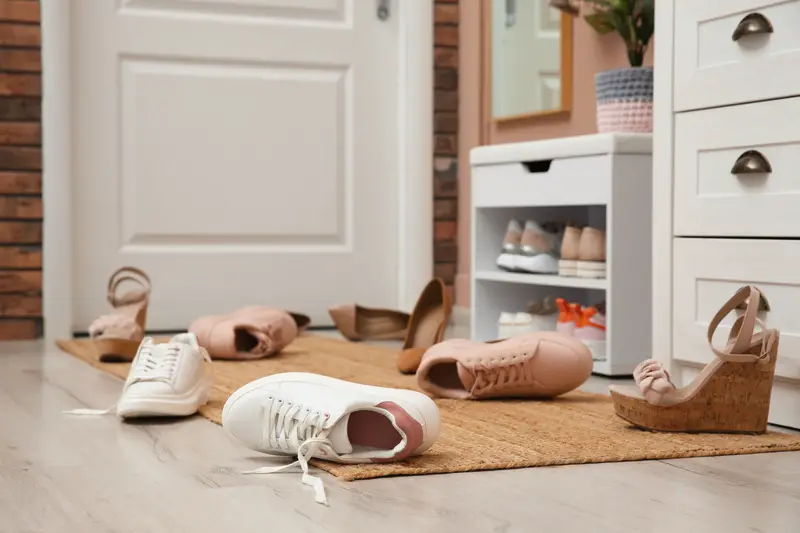Walking into a cluttered entryway after a long day is like hitting a wall of stress before you even put your bags down. We’ve all been there – keys lost under piles of mail, tripping over shoes, and wondering how your front door area became a catch-all for everything you own. Your entryway is your home’s first impression, both for guests and for yourself when you return home. But many of us are making the same mistakes, turning this space into a chaotic dumping ground instead of the welcoming transition area it should be. Ready to transform your entryway from stress-inducing to stress-relieving? Let’s look at what needs to go.
Piles of unsorted mail create security risks
Those innocent-looking stacks of mail in your entryway aren’t just an eyesore – they’re potentially exposing your personal information to anyone who walks through your door. Think about it: bills with account numbers, credit card offers, healthcare statements, and other sensitive documents just sitting there for all to see. Even if you trust everyone who enters your home, having this information visible creates unnecessary risk. Plus, important documents often get lost in these piles, leading to missed payments or opportunities when they’re buried under catalogs and junk mail.
The smart solution is creating a simple mail sorting system away from your entryway. A small file box with basic categories like “to pay,” “to read,” and “to file” tucked in a kitchen drawer or home office works wonders. For mail you need to take with you, use a single, dedicated folder in your bag rather than leaving it in the open. Consider investing in a mail organizer that can be mounted on the wall to keep paper off horizontal surfaces entirely, making your entryway look more spacious while protecting your private information.
Your entire shoe collection belongs elsewhere
Let’s be honest – most entryways aren’t equipped to handle your complete shoe collection, yet many of us try to cram every pair we own into this small space. Not only does this create an instant visual traffic jam when you walk in, but it also makes finding the right pair frustrating when you’re rushing out the door. Even worse, shoes track in dirt, mud, salt in winter, and all kinds of outdoor gunk that’s now concentrated in the first area people see in your home. This mess creates a negative first impression and can actually damage your flooring over time.
The fix is simple: limit entryway shoes to just 1-2 pairs per person that you’re currently wearing this season. The rest should go in closets, under beds, or in dedicated shoe storage cabinets elsewhere in your home. For the few pairs that do stay in the entryway, consider a narrow vertical rack that uses height rather than floor space. This simple change makes your entryway look instantly bigger and creates a cleaner, more welcoming first impression. When shoes aren’t scattered everywhere, you’ll also find it’s much easier to clean this high-traffic area.
Off-season coats and jackets waste precious space
Those bulky winter coats hogging your entryway hooks in July aren’t just unnecessary – they’re actually getting damaged and making your space feel cramped. Entryway coat storage is prime real estate that should change with the seasons, just like your wardrobe does. When heavy coats sit unused for months, they collect dust, can become misshapen from improper hanging, and prevent you from easily grabbing the light jacket or raincoat you actually need right now. Many entryways have limited hanging space to begin with, so why waste it on items you won’t touch for months?
Creating a seasonal rotation system for your outerwear takes just one afternoon but pays off all year. When the weather changes, pack away off-season coats in vacuum storage bags or breathable garment bags and store them in a closet, under a bed, or in another storage area. This protects your investment in quality outerwear while freeing up valuable entryway space. Leave only current-season jackets on display, and you’ll be amazed at how much more functional and open your entryway feels. This simple change also makes it easier to find what you need without sorting through items you won’t wear for months.
Children’s toys create tripping hazards
Kids’ toys have a magical ability to multiply and migrate throughout your home, but allowing them to colonize your entryway creates real problems. Beyond the obvious clutter, toys in the entry area become serious tripping hazards, especially when you’re carrying groceries or when visitors aren’t familiar with navigating your toy obstacle course. The entryway is also one of the dirtiest areas of your home since it connects directly to the outside world. Toys that live here collect more dust, dirt, and germs than toys stored in cleaner areas of your home, which is particularly concerning for items that younger children might put in their mouths.
Creating a dedicated toy zone away from the entryway benefits everyone. For younger kids, try placing a colorful toy chest or storage bins in their bedroom or playroom where they can easily access their favorites. For older kids, consider a “one in, one out” rule for toys in common areas – if something new comes out, something else gets put away first. Many parents find success with a small basket near the entryway for quick cleanup, but the key is emptying this container daily rather than letting it become permanent toy storage. Your entryway will be safer, cleaner, and far less chaotic.
Sports equipment brings dirt and damage indoors
That row of baseball bats, soccer balls, tennis rackets, and other sports gear lining your entryway walls might seem convenient, but it’s causing more problems than you realize. Sports equipment is often dirty from outdoor use, bringing grass, mud, and other debris straight into your home. These items are also typically oddly shaped and bulky, making them major space-hogs in an area that’s already tight on square footage. When propped against walls, they can leave marks or dents, especially on painted surfaces. Plus, constantly moving equipment around to get to other items creates wear and tear on both your walls and the gear itself.
A better approach is creating a dedicated sports zone in your garage, basement, or utility room. Wall-mounted racks and sports organizers keep everything visible yet contained, protecting both your equipment and your home’s surfaces. For apartments without these extra spaces, consider under-bed storage containers or the back of a closet. If you absolutely must keep some equipment near the door, limit it to one small, contained bin that can be easily moved for cleaning. Your entryway will look more pulled together, and your sports gear will last longer when properly stored.
Mounting package piles block pathways
With online shopping becoming second nature, many of us are guilty of letting delivered packages pile up in our entryways. While it might seem harmless to let that stack of boxes sit for a few days, this habit creates several problems. First and most obvious is the safety issue – packages can quickly become tripping hazards, especially in a dark entryway or when you’re in a hurry. They also advertise to anyone looking through windows or open doors that you’ve received deliveries, potentially making your home a target. From a practical standpoint, boxes take up valuable floor space in what’s typically already a tight area.
Designate a specific time each day to process incoming packages – opening them, breaking down boxes, and putting the contents away where they belong. For households receiving frequent deliveries, consider adding a package delivery box outside your home for more security. Inside, a small basket or bin can temporarily hold smaller packages until you have time to deal with them, but make this a transitional solution, not permanent storage. By processing packages promptly, you’ll keep your entryway clear, maintain better security, and actually enjoy your new purchases faster rather than tripping over them for days.
Broken furniture wastes valuable square footage
That wobbly chair or rickety side table you’ve been meaning to fix has no place in your entryway. Broken or damaged furniture doesn’t just look bad – it can actually be dangerous, especially in a high-traffic area like your entrance. When space is already at a premium, why waste it on items that aren’t fully functional? Many people use their entryway as a holding area for furniture they plan to repair “someday,” but let’s be honest – if it’s been sitting there for months, that repair probably isn’t happening anytime soon. This makeshift furniture graveyard creates a cluttered first impression and takes up space that could be used much more effectively.
It’s time for some honest decisions about those broken items. If you truly plan to fix something, set a deadline and stick to it – one month is usually reasonable. If the deadline passes without repair, it’s time to let it go. For furniture with good bones that needs professional help, research local furniture repair services or buy a quality repair kit and make it a weekend project. For beyond-repair items, consider recycling or listing as “free for parts” online. Your entryway deserves furniture that’s both beautiful and functional – anything else is just taking up valuable space.
Bags and backpacks create visual clutter
Work bags, backpacks, purses, and totes seem like logical items to keep by the door, but when permanently stored in your entryway, they create unnecessary visual noise and take up significant space. These items tend to multiply – most people have far more bags than they regularly use, yet all of them end up hanging on hooks or sitting on your entryway bench. This not only looks messy but also makes it harder to find the specific bag you need when rushing out the door. Plus, constantly brushing past bags in a narrow space can wear them out faster, damaging items you’ve invested good money in.
A better system is to keep only your current, everyday bag in the entryway and store the rest elsewhere. Consider a dedicated drawer or shelf in your bedroom closet for purses and special occasion bags. For backpacks and work bags, try hooks inside a closet door or a hanging organizer where they’re out of sight but still accessible. If you rotate bags frequently, implementing a “one-in, one-out” policy helps maintain order – when you switch to a new bag, the old one gets properly stored away. This simple change makes your entryway look instantly more organized while better protecting your bag collection.
Your entryway sets the tone for your entire home – it’s both the first thing you see when you arrive and the last thing you see when you leave. By removing these common clutter culprits, you’ll create a space that feels welcoming rather than overwhelming. Start with just one category today – whether it’s dealing with that mail pile or finally finding a proper home for the sports equipment. Small changes in this key area can dramatically improve how your entire home feels and functions. Your future self will thank you every time you walk through your front door and aren’t greeted by chaos.

